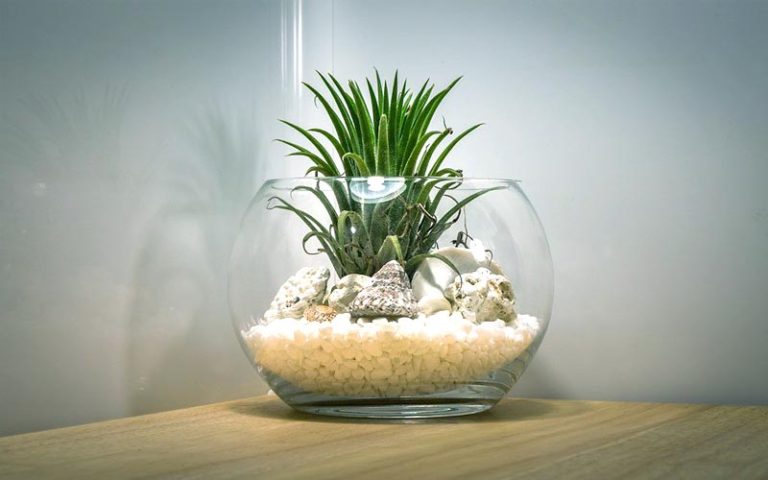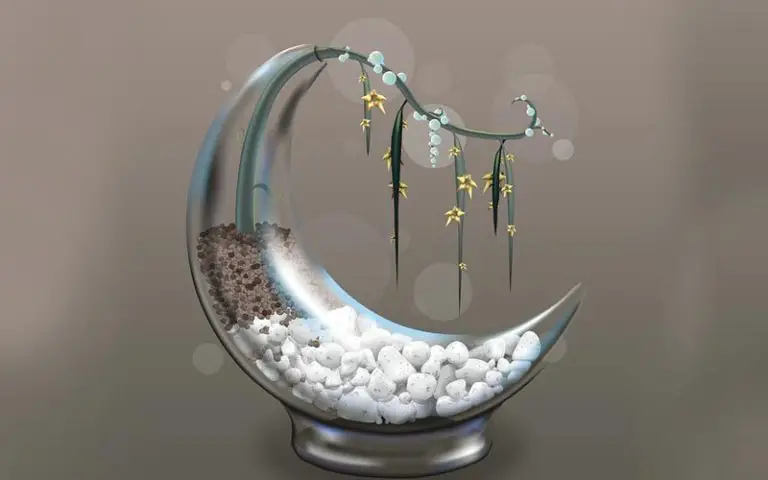How Does a Bonsai Terrarium Work?

A bonsai terrarium is the ultimate, advanced experience if you want to create an outstanding landscape inside a glass container. While it looks stunning in any collection, it doesn’t always work and the success rate is low. Under the right conditions, you can pull it off and craft something unique and beautiful.
In this guide, we’ll investigate whether is a bonsai terrarium is possible, which species work, and how you can make your own one at home!
Can You Grow a Bonsai Tree In a Terrarium?
It’s absolutely possible to place a bonsai inside a terrarium. The technique is more advanced, so we don’t recommend it for beginners. However, you can go ahead if you have green fingers and years of experience with these miniature landscapes.
You can use glass containers of any size, as long as it builds a beautiful context with the bonsai and related greenery. The options include open and closed terrariums, with the former allowing for fresh airflow and the latter uses condensation to water the soil. Succulents are ideal for the open version while a rainforest setting will work for a closed environment.
Selecting the Appropriate Species
Sadly, not all bonsais survive in terrariums. There are three primary elements to consider before you place a tree inside the glass container, namely, tree size, tolerance to moisture, and preferred humidity levels. If you’re aiming at an open jar, you can get away with several bonsai species.
However, closed bonsai terrariums are more tricky. There’ll be excessive humidity and the soil will almost always be moist. You’ll want species that love wet roots or a rainforest environment. You won’t have many choices in this regard, but there are a few that may survive.
Here are our top choices for bonsais to grow in terrariums:
- Ficus
- Bougainvillea
- Bald Cypress
- Fukien Tea
- Brazilian Rain Tree
- Water Jasmine
Ficus
We’ve selected the Ficus bonsai as our best choice for a terrarium for several reasons. Firstly, it’s incredibly forgiving and can withstand extremely poor conditions. It’s also fond of being indoors, while it loves high humidity levels.
Bougainvillea
The Bougainvillea thrives in the tropical regions of the United States, as it loves warm climates and high humidity. It’s a thirsty plant, so the condensation will work wonders in the summer. You won’t need to water it as regularly as the other trees in your collection.
Bald Cypress
You’ll find the Bald Cypress in Louisiana and Florida due to the swampy and humid climate. As it loves soaking its roots in water, it’s one of the few bonsai trees that will perform incredibly well in an enclosed terrarium. You won’t need to worry about root rot or other soil diseases impacting its growth.
Fukien Tea
A fan of heat and humidity, the Fukien Tea bonsai is another species that will thrive in a terrarium. The glass plays off well against the red berries, white flowers, and glistening green leaves. It’ll certainly put on a show for you and your guests in summer.
Brazilian Rain Tree
As the name implies, this species is native to the rainforests found in Brazil. As you can imagine, a terrarium provides the ideal conditions for the bonsai, gracing it with moisture and humidity. You’ll want to aim for the closed version so that it can receive as much heat and condensation as possible.
Water Jasmine
Finally, the Water Jasmine enjoys as much liquid as you can give it, while it thrives in high humidity. The white flowers look stunning in a small setting, but you may want to add a small waterfall feature. Placing some moss around it will create the effect of grass.

The Benefits of Terrariums
It may be hard to believe, but there are a few pros to growing your bonsai inside a terrarium. They aren’t many and only apply to species that work well in them. Still, the advantages are worth considering if you’re thinking of creating this small ecosystem.
Here are the benefits of a bonsai terrarium:
- Low watering requirements due to the constant condensation
- Creates high humidity levels when you live in a dry climate
- Displays a gorgeous landscape
- Doesn’t take up too much space
- You can add grow lights to the top of the container
How to Create a Bonsai Terrarium
If we’ve excited you about the idea, we have a few steps for how you can create your own terrarium for your bonsai. You can change some of the ideas or concepts, but some of the steps are mandatory. Remember to select a species that best suits this environment.
- Clean the container: You’ll want to sanitize the glass so that it doesn’t transmit any lingering pests or diseases.
- Drainage: Since the glass won’t have any holes for drainage, you need to provide a solution. We recommend adding some stones as a bottom layer so that the water can seep down into it.
- Terrarium soil: Next, you should place some soil over the stones. Aim for ones that have less chance of developing fungi or bacteria. You can ask your local store for the best type.
- Slope: Now, you’ll want to add another layer of soil at an angle. Your landscape and bonsai tree will live on this slope, so make sure you compact it so it’s not too loose and provides a good structure.
- Decoration separation: If you want to, you can place some deco rocks at the point where the two soil layers meet. It creates a beautiful barrier while also securing the soil in the container.
- Plant your bonsai: The time has arrived for your to place your bonsai in the topsoil. Ensure it’s stable and the soil is compact around the roots and trunk’s base. The last thing you want is to have it fall over after all your effort.
- Sand: You can add fine sand to some of the sections to create pathways or give it a defined look. Try not to cover all the soil with it.
- Moss: You can also place some moss to look like grass in your terrarium. It gives it a refined appearance and will contrast with the other colors.
- Final decorations: If you want to create the final scene, you can add some more decorations or stones on the slope. It’ll not only make the landscape look amazing, but it also will hold everything in place.
- Misting: Now, take your spray bottle and mist the terrarium. Try not to add too much water, as it may drench the soil and cause problems at a later stage.
- Placement: Finally, close the lid and put the bonsai terrarium on a window sill that has full light. You’ll notice in a few days that condensation forms, enabling a high humid environment.

Caring for Your Small Landscape
With your ecosystem established in the glass container, it’s time to provide proper care. You can’t simply sit back and expect the bonsai to look after itself. Here are some things to keep an eye on over the year.
Light
While the terrarium will enjoy full sunlight, it also depends on the bonsai species. You don’t want the leaves to burn from the play of the light on the glass. You should aim for five hours of light in the morning, with some shade in the afternoon. Another option is a glow light.
Soil
Most people use Akadama soil, as it’s well suited to these environments. It becomes like hard pellets that allow for excellent drainage, and you won’t find mold forming like with the standard mix. Make sure the substrate remains stable at all times.
Transplant Issues
When you move your bonsai into this new ecosystem, it’ll go through a short period of shock until it adjusts. You may notice brown or falling leaves, bruises, or some slight deformation in the branches. It’s best to remove the dying foliage until the tree becomes used to the terrarium.
Pest and Diseases
Even though your terrarium has a lid you can close, there are times that tiny pests still find their way in if it’s not properly secured. You may also need to deal with mold from the moisture in the soil. You can treat it with hydrogen peroxide mixed with water, while you can also remove the top mold with a knife.
Maintenance
Of course, you should continue with normal pruning practices. You don’t want the leaves and branches to expand too quickly inside the container, as they may become too dense or press against the walls. Try to keep the original design as much as possible.
Watering
You won’t spend as much time watering as in standard situations. The condensation and high humidity will do the work for you, seeling in the liquid as much as possible. However, you should still check that there isn’t too much or too little, as either extreme can harm your bonsai.
Temperature
The closed environment will cause heat to remain in the jar with nowhere to escape. It’s best that you open the lid now and again to promote healthy air flow and temperatures. When winter arrives, we recommend wrapping something around the jar to keep the same levels, as the bonsai won’t like extreme variations too much.
Fertilizer
Inoculant fertilizer is perfect for these conditions, as it adds small organisms to the soil that will help the bonsai thrive. You can also use foliar fertilizer that’s applied to the leaves instead of the soil if you don’t want any issues with the roots.
Repotting
Just like with any bonsai, you’ll need to repot the environment every alternate year. It gives the roots room to grow and breathe, while the new soil will be a blessing. You’ll also have an opportunity to try a new landscape design.
Final Thoughts
Designing a terrarium for your bonsai is an advanced technique you can use to show off your skills. It’s incredibly challenging to get right, but it presents a beautiful display that’ll have your family and friends in awe. Feel free to share your designs with us on Instagram.

FAQs
Before you leave, here are some questions we found online that may be helpful to you. If you don’t see your query answered in this article, please feel free to drop us an email. We’ll add it to our list for everyone to enjoy.
Yes, you can grow bonsais in open and closed terrariums. Not all species enjoy the latter, but we’re sure you can find some that will thrive in that environment. As long as you look after it, the tree will blend well into the ecosystem you created.
In most instances, plants in closed terrariums recycle the air, changing carbon dioxide to oxygen. It doesn’t do any harm to the bonsai or other micro-organisms, which will use the gases to their own advantage. However, it’s a good idea to open the lid and allow some fresh air in now and again.
There’s no reason that a well-maintained environment can’t thrive for a very long time. The oldest known terrarium is more than fifty years old, and it shows no sign of dying any time soon. As long as it has the right conditions and care, it can live for more than a hundred years.







